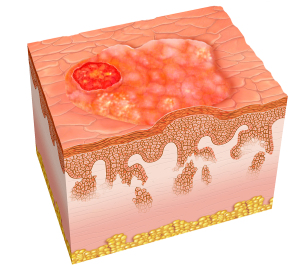Introduction
Skin cancer is a very common cancer. It is visible, it can be diagnosed early and generally speaking the prognosis is very good as it tends to metastasize much later than for instance melanoma does. However, the topic of skin cancer is not as simple as it may sound at first glance.
There are 29 histologically different types of skin cancer beside melanoma (which is pigmented and is dealt with under its own heading). The reason for this is as follows.
There are three layers of the skin: the superficial layer (epidermis), the dermis and underneath the dermis is the subcutaneous tissue. Each of these layers has substructures, which would be too detailed and perhaps inappropriate to explain here. Each of these substructures can turn malignant resulting in a total of 29 different skin cancers.
We will concentrate on the most common skin cancers here and deal with them in some detail. They all develop from the epidermis layer and they are the basal cell carcinoma and the squamous cell carcinoma. Generally speaking any skin cancer is detected by the fact that something grows on the skin, which has not been there before and becomes gradually more protruded or grows in width. When this happens, see your physician for diagnosis and further advice regarding what to do.
Statistics
In the white population of the U.S. the non-melanoma skin cancer is the most common cancer with a frequency of more than 700,000 new cases diagnosed every year. The mortality rate is only about 2100 per year and improving as close to 100% of skin cancer should be curable, if detected early and removed at that stage (Ref. 6).
Basal cell carcinoma accounts for about 75% to 80% of the cases and squamous cell carcinoma accounts for the other 20 % to 25%. The remainder (1 to 2%) is the mix of the remaining 27 types and includes such tumors as soft tissue sarcomas of the dermis and the subcutaneous tissue. Basal cell carcinoma is more frequent in men than women and is rare in people with black skin (Ref. 5 and 6). However, in younger people recently there has been an increase of basal cell carcinomas. In people with dark skin, on the other hand, squamous cell carcinoma is the most common skin cancer. People with white skin who get sunburns easier basal cell carcinoma develops commonly on the sun exposed areas of their bodies.
For pigmented skin cancers, called melanomas, click here: melanomas.
References:
1. Kripke ML, Sass ER,eds.”Antigenicity of murine skin tumors induced by UV light”.JNCI 1974;53:1333-1336.
2. Kripke ML. “Immunology and photocarcinogenenis”. J. Am. Acad.Dermatol. 1986;14:149-155.
3. Potter M.”Percivall Pott’s contribution to cancer research”. NCI Monogr.1963;10:1.
4. COMS Group: Collaborative ocular melanoma study manual of procedures. National Technical Information Service. Springfield,VA, 1989.
5. Cancer: Principles &Practice of Oncology. 4th edition. Edited by Vincent T. DeVita, Jr. et al. Lippincott, Philadelphia,PA, 1993. Chapter on Cancer of the skin.
6. Cancer: Principles&Practice of Oncology. 5th edition, volume 2. Edited by Vincent T. DeVita, Jr. et al. Lippincott-Raven Publ., Philadelphia,PA, 1997. Chapter on Cancer of the skin.
7. Conn’s Current Therapy 2004, 56th ed., Copyright © 2004 Elsevier
8. Ferri: Ferri’s Clinical Advisor: Instant Diagnosis and Treatment, 2004 ed., Copyright © 2004 Mosby, Inc
Also look for more info at these sites:
http://www.skincarephysicians.com/actinickeratosesnet/index.html







